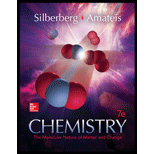
(a)
Interpretation:
Reaction energy diagram has to be drawn.
Concept introduction:
Activation energy: The minimum energy required for the collision to be effective for the colliding molecules is said to be activation energy. Activation energy plays an important role in
Reaction: Substances which are mutually involved each other in a chemical process and changed into different substances.
Mechanism of a reaction: The representation of step by step process involved in the chemical process is said to be mechanism of a
Enthalpy: In
Rate of reaction: It represents the speed at which a chemical reaction runs. How much concentration of reactants consumed and how much concentration of product formed in a unit of time is said to be rate of reaction.
(b)
Interpretation:
The value of
Concept introduction:
Activation energy: The minimum energy required for the collision to be effective for the colliding molecules is said to be activation energy. Activation energy plays an important role in chemical kinetics. It was introduced by Swedish scientist Svante Arrhenius in 1889.
Reaction: Substances which are mutually involved each other in a chemical process and changed into different substances.
Mechanism of a reaction: The representation of step by step process involved in the chemical process is said to be mechanism of a chemical reaction.
Enthalpy: In thermodynamics, the total heat content of a system is equivalent to the thermodynamic quantity is said to be an enthalpy of a reaction.
Rate of reaction: It represents the speed at which a chemical reaction runs. How much concentration of reactants consumed and how much concentration of product formed in a unit of time is said to be rate of reaction.
(c)
Interpretation:
Possible transition state has to be sketched.
Concept introduction:
Activation energy: The minimum energy required for the collision to be effective for the colliding molecules is said to be activation energy. Activation energy plays an important role in chemical kinetics. It was introduced by Swedish scientist Svante Arrhenius in 1889.
Reaction: Substances which are mutually involved each other in a chemical process and changed into different substances.
Mechanism of a reaction: The representation of step by step process involved in the chemical process is said to be mechanism of a chemical reaction.
Enthalpy: In thermodynamics, the total heat content of a system is equivalent to the thermodynamic quantity is said to be an enthalpy of a reaction.
Rate of reaction: It represents the speed at which a chemical reaction runs. How much concentration of reactants consumed and how much concentration of product formed in a unit of time is said to be rate of reaction.
Want to see the full answer?
Check out a sample textbook solution
Chapter 16 Solutions
Student Study Guide for Silberberg Chemistry: The Molecular Nature of Matter and Change
 ChemistryChemistryISBN:9781305957404Author:Steven S. Zumdahl, Susan A. Zumdahl, Donald J. DeCostePublisher:Cengage Learning
ChemistryChemistryISBN:9781305957404Author:Steven S. Zumdahl, Susan A. Zumdahl, Donald J. DeCostePublisher:Cengage Learning ChemistryChemistryISBN:9781259911156Author:Raymond Chang Dr., Jason Overby ProfessorPublisher:McGraw-Hill Education
ChemistryChemistryISBN:9781259911156Author:Raymond Chang Dr., Jason Overby ProfessorPublisher:McGraw-Hill Education Principles of Instrumental AnalysisChemistryISBN:9781305577213Author:Douglas A. Skoog, F. James Holler, Stanley R. CrouchPublisher:Cengage Learning
Principles of Instrumental AnalysisChemistryISBN:9781305577213Author:Douglas A. Skoog, F. James Holler, Stanley R. CrouchPublisher:Cengage Learning Organic ChemistryChemistryISBN:9780078021558Author:Janice Gorzynski Smith Dr.Publisher:McGraw-Hill Education
Organic ChemistryChemistryISBN:9780078021558Author:Janice Gorzynski Smith Dr.Publisher:McGraw-Hill Education Chemistry: Principles and ReactionsChemistryISBN:9781305079373Author:William L. Masterton, Cecile N. HurleyPublisher:Cengage Learning
Chemistry: Principles and ReactionsChemistryISBN:9781305079373Author:William L. Masterton, Cecile N. HurleyPublisher:Cengage Learning Elementary Principles of Chemical Processes, Bind...ChemistryISBN:9781118431221Author:Richard M. Felder, Ronald W. Rousseau, Lisa G. BullardPublisher:WILEY
Elementary Principles of Chemical Processes, Bind...ChemistryISBN:9781118431221Author:Richard M. Felder, Ronald W. Rousseau, Lisa G. BullardPublisher:WILEY





